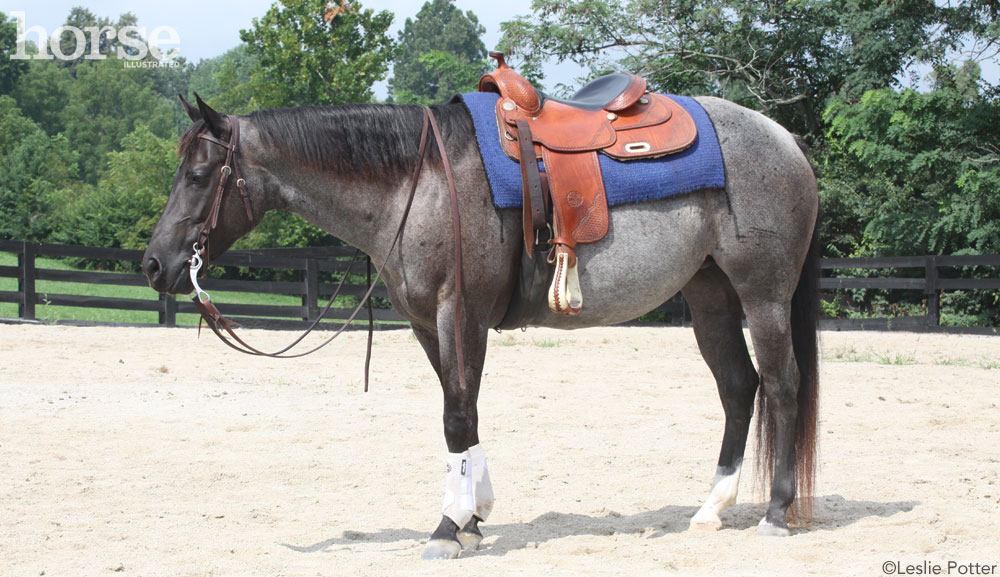
Remember the last time you were out walking and got a small pebble in your shoe, or wore a new pair of hiking boots only to find they were pinching your toes or rubbing a heel the wrong way? If you could not stop immediately to remedy the problem, you quickly found a way of walking that minimized the discomfort until you could. You may also have become very vocal about your pain until companions slowed down to help you find a solution.
- Mounting your horse is a nightmare. It makes no difference if you mount from the ground, use a mounting block, face him into a corner or have a helper. The fidgeting and prancing make you dread the start of every ride.
- Circling to the right, your horse bends smoothly from nose to tail and stays relaxed. Change directions, however, and you have a changed horse. He cranks his tail, chews his bit and fights to tip his nose to the outside. Why, you fret, does he have to be so contrary in one direction?
- Your horse moves quietly on a loose rein. But ask for a bit of collection, and he begins to grind his teeth and stiffen. You faithfully follow the routine your trainer advised for putting him on the bit each time you ride, but he is not getting any better.
- You gave your horse the winter off and he put on a few pounds. Now that you are back in the saddle, you find your high-headed horse is carrying himself higher than ever and tossing his head to boot, particularly at the beginning of a ride. You’ve always used a tie-down, but the head tossing is so violent you’re beginning to worry the equipment might break.
- A friend arrives for a trail ride, puts her own favorite saddle on your mare and mounts up. You watch with horror as your old, reliable pussycat pins her ears, gets a hump in her back and threatens to toss your friend before the ride even begins.
If these horses were children, we could say they were acting out. What we need to do is look at their behaviors as communication. While there are no magic tricks in horse training, and there can often be more than one reason for particular behaviors, each of these horses may be telling the rider that the saddle is hurting his back.
Why Is Fit Important?
If we only rode bareback, our horses would soon become sore where our seatbones continually dig into their back muscles. We, too, would become sore from sitting on the same anatomical points without relief and from the continual muscle tension needed to maintain our balance as the horse’s muscles and skeleton wiggle and bend beneath us. Putting aside fantasies about flying through flower-strewn meadows with manes and hair blowing in the wind, there are some very practical reasons why saddles were invented.
Saddles serve two functions. They protect a horse from the drilling pressure of the rider’s seatbones by spreading that pressure out over a wider load-bearing surface, and they provide riders with a comfortable seating surface on a stable platform, which helps them maintain correct posture for long periods of time. The tree also provides a place to hang stirrups, which help a rider distribute weight along an anatomical continuum from the seat, to the thighs, to the knees, to the balls of the feet. This not only gives greater security, but also more comfort on longer rides.
The saddle’s rigid tree is the key element that provides both of these benefits. If the tree doesn’t fit, neither will the saddle. Fitting a rigid platform to a curvaceous back with angles that constantly change as the animal moves has been the saddle maker’s challenge over the centuries.
A western saddle’s tree, not its leather skirts, is what supports and spreads the rider’s weight over the horse’s back. The tree’s fork must have the correct width and flare to fit the horse’s withers without rubbing them and fit the shoulders without pinching or constricting. The fork and the cantle are joined by curved sides, or bars. If the bars do not contact the horse’s back smoothly from fork to cantle, the tree will either rock or bridge (sit on its four “corners”) creating pressure points.
Although an English tree is shaped differently, the head or pommel must also fit the horse’s withers and shoulders without rubbing or pinching. However, the side pieces connecting the head to the cantle are narrow and set much higher up than those of a western saddle. They form the basis of a seat for the rider, but are not intended to conform to the horse’s back.
Instead, panels stuffed with wool flocking, synthetic flocking, natural or synthetic felt, or various kinds of foam sit between the horse’s back and this rigid seat to spread the rider’s weight over a larger area. If the stuffing is not in the right shape to fit a particular horse’s anatomy, the result can be pressure points or a bearing surface that’s too small to spread the rider’s weight adequately.
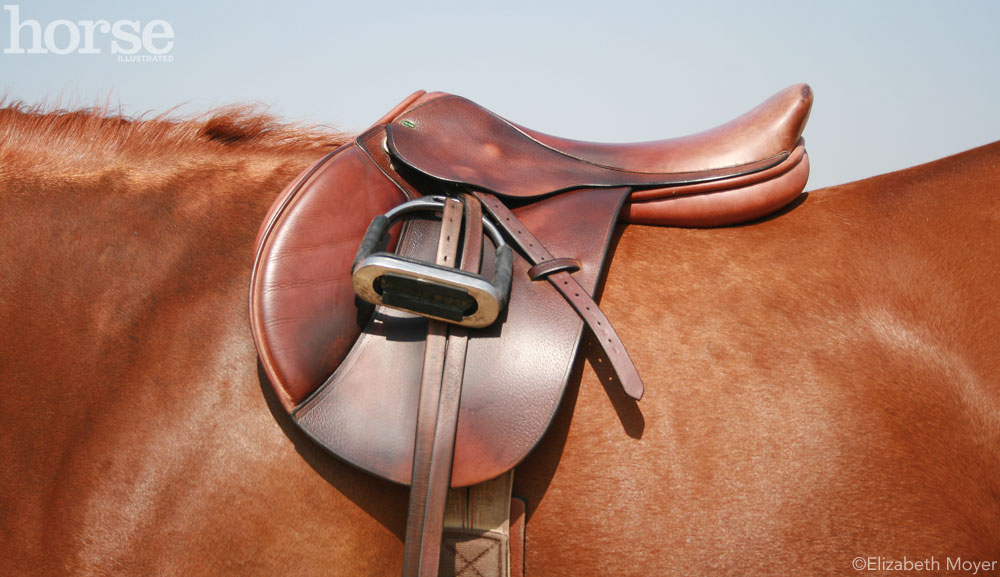
Checking for Fit
A properly fitted saddle sits securely in place without touching the horse’s spine. It has no tendency to rock from side to side or front to back. Most importantly, it provides a broad load-bearing surface that fits flush along the horse’s back muscles on either side of the spine. Follow these steps to check the fit of your saddle:
- Place the saddle on the horse without a pad or girth, making sure it is in the right spot on his back. Try rocking it from side to side and front to back. It should feel like it is seated firmly, with no tendency to move around easily on the horse’s back.
- Check that the saddle clears the horse’s withers and spine. Two to three fingers held vertically should fit between the pommel or fork and the horse’s withers. Depending on the size of your fingers, that much space may be unnecessary, but look for at least an inch of clearance. Sight down the saddle from the rear to the front for daylight, to make sure the middle of the saddle is not touching the spine. If your hands are small, you may be able to reach in from the front of the saddle to check for spine clearance.
- Lift a western saddle’s stirrup or an English saddle’s flap, and try to work your hand between the horse’s side and the saddle. This should be difficult to do if the saddle fits snugly and securely along the length of the back. If a western saddle is bridging, you may find a slight gap here that makes it easier to slide your fingers under the bars. Examine an English saddle to see if the stuffed panels make even contact from front to rear. Many saddle panels make good contact only about two-thirds of the way back, while the rear portion of the panels rides uselessly up in the air.
-
If everything checks out so far, add a pad and the girth, and continue your examination. Recheck to be sure the saddle is firmly seated and that there is adequate clearance at the withers.
Padding narrows the tree; how much will depend on the thickness and rigidity of the pad. Observe from the side whether adding the pad has narrowed the tree so much that the saddle now tips backward and the seat is no longer level.
- Run your hand between the saddle and the horse’s shoulder from the top of the fork or pommel past the front edge of the tree. The fit should be snug but not pinching. You should not have to struggle to slide your hand down. If you are doubtful, leave your hand between the horse’s shoulder and the front edge of the tree as a friend leads the horse forward. The horse’s shoulder blade should slide freely back and forth under the edge of the tree, or the points of the English saddle tree’s pommel. If things are still looking good, put a rider in the saddle. Weight in the saddle may change fit dramatically.
- Recheck wither and spine clearance.
- Run your hand between the horse’s shoulder and the front edge of the tree again. If there is any question about whether or not the tree is digging into the horse’s shoulders, keep your hand under the front edge of the tree, or the point pockets on an English saddle, while a friend leads your horse forward and into turns. If your fingers feel crushed as the shoulder blade slides under the edge of the tree, you can bet the horse’s shoulder muscles feel that way, too.
Fitting Both of You
Many riders spend hours sitting in saddles at tack shops to find the model that fits them best. Then they head home, throw it on their horse and never stop to think that the saddle has to fit the horse as well. Finding a saddle that fits you both can be a frustrating search. If you have to compromise, however, make it on your side of the saddle. Why? Because pain from a poorly fitting saddle will cause negative horse behaviors, ranging from annoying to unsafe. Until you remove that source of pain, you won’t solve those behaviors with gadgets like tie-downs or piles of pads.
The combination of horse plus saddle plus rider is not static. It constantly moves and shifts at every stride. And what fits today may not fit the same way tomorrow if horse or rider gains or loses weight or muscle. A young animal’s back may change dramatically until he is about 5 years old. The out-of-shape adult horse that finally gets back in shape will have different musculature at the end of his conditioning program than he did at the start. The senior horse’s back is likely to change with age. Repeat your saddle-fitting check periodically to make sure your saddle is still comfortable for your horse and you will be rewarded with a happier horse that can concentrate on the day’s lessons instead of the pain in his back.
Read on for more on tack fit.

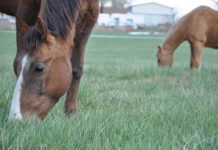
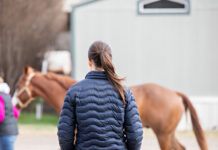
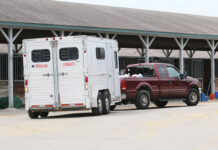



Thanks for the help. I can’t tell if my mare’s “attitude” is because the saddle bothers her or if she is just having a mare mood! I will take the Saddle Fit info with me to the barn to check out the problem.
I just wanted to say thnaks so much for this article! I have always struggled to try and figure out if a saddle fits correctly on my own. This article has helped me so much. And it’s all true! Thanks again!
I just wanted to say thnaks so much for this article! I have always struggled to try and figure out if a saddle fits correctly on my own. This article has helped me so much. And it’s all true! Thanks again!
I think the article was extremely well written. I intend to use it during my new saddle selection process. I think the advise given was excellent.
very well written and easy to follow. thank you!
This article on Saddle Fitting provided helpful for me and my horse.
This was a very detailed and helpful article.
Thanks for the informative and practical article!
great article
In my opinion, Supracor pads are the best. They use newer technology and the pads are filled with “honeycomb” material that evenly dispenses pressure. I just bought my second one, a Supracor “Cool Grip”. It’s so ventilated for cooling the back you can actually see through tiny holes in it. My horses love them. They are worth the high price!
Saddle fit is very important
This article is great! I’ve been having trouble trying to find out if my saddle fits or not, so this is a big help. I’ve looked at other articles, but this one goes into more detail in my opinion. Thanks guys! I’m going outside right now to try it out. Wish me luck!